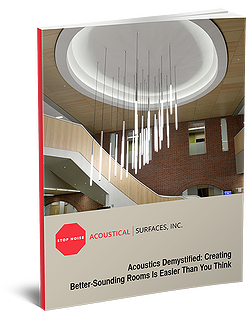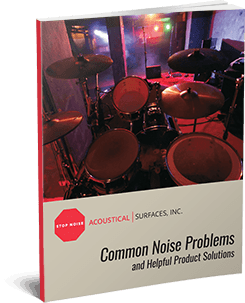Why Control Noise? The Cost of Noise Pollution
Noise pollution is a growing problem in our modern world. We are constantly being bombarded by sound waves created by technology and overcrowding, and chronic exposure to unsafe noise levels can create unintended consequences for all those who endure it.
Noise control measures are necessary for all workplaces interested in maintaining the mental and physical health of their employees. In some cases, noise pollution even represents workplace safety concerns that are required by law to be controlled. The 1990 Clean Air Act and OSHA Standards both highlight the importance of reducing noise exposure and mandate remediation efforts when levels are deemed inappropriate.
If your workplace has a noise problem, there are some great reasons to look into abatement measures.
The True Cost of Noise Pollution
Noise pollution refers to the presence of harmful or disturbing levels of noise in the environment. Most instances of noise pollution are caused by human activities, including day-to-day conversation and activities, as well as through the use of technology and heavy machinery.
When we are exposed to noise pollution that surpasses safe thresholds over extended periods of time, we will likely experience health, safety, and productivity issues over time. Implementing noise control solutions keeps us happier, healthier, and can even make us more effective at completing tasks at work.
With all this in mind, identifying both sources of noise and effective measures to control it are prudent behaviors for employers in industries that generate considerable amounts of noise. It is not only important for protecting employees against hearing loss and associated medical expenses, but also for reducing noise-induced fatigue, which improves productivity and helps prevent accidents.
Why Noise Control is Essential
Addressing environmental noise issues is crucial for businesses and communities alike. When workers and community members are exposed to excess noise, it can increase health issues like stress and tinnitus that can lead to decreased concentration and poor performance. This has negative effects on company productivity as well as reputational standing within the community.
OSHA’s Noise Standard dictates that employers must reduce occupational noise exposure through engineering controls, administrative controls, or hearing protection devices to attenuate the occupational noise received by employee’s ears to acceptable levels if their workplaces experience noise levels that exceed OSHA noise limits over a set number of hours.
Implementing noise control measures delivers big benefits for the company as well. It fosters better communication, reduces workplace errors, and generally improves company morale through a culture of caring.
Identifying Noise Sources
There are typically two main types of noise we deal with in workplaces. One is point-source noise, which is created by a single, localized source like industrial machines, pumps, and blowers. If these sources are extremely loud, they can have immediate effects on hearing health. Even at lower levels, prolonged exposure can lead to increased stress and anxiety, reduced communication effectiveness, and decreased concentration and focus.
The second type of noise we typically see in the workplace is the cumulative, untraceable noise caused by things like conversations and smaller tools on site. They may seem minor at first glance, but when added together, these sounds can have major impacts on large, open spaces.
These noise sources may create high frequencies or low frequencies, and the damage done from each type looks a little different. High-frequency noise includes things like whistles and squeaky conveyors, while low-frequency noise includes things like loud rumbling or droning. Here is the difference between the two, as far as damage is concerned.
- High-frequency noise often results in pain, hearing loss, and tinnitus. It is more damaging to the auditory system and causes immediate discomfort.
- Low-frequency noise is more likely to cause fatigue, vibration-related discomfort, and stress. Its effects are generally felt over time.
Effective Noise Control Strategies
There are a number of effective strategies that can be employed when implementing noise control measures in any workplace. Some involve preventing noise at the source, while others are aimed at blocking or absorbing noise within the working environment.
Preventing Noise
Point-source noise originating from machinery is often caused by old models or ones that have not been properly maintained. If the machinery is old, upgrading it to a newer, quieter model may save ear strain and deliver efficiency benefits at the same time. If the machinery still has plenty of life left in it, proper routine maintenance will often reduce kinetic noise (the noise generated by movement of objects or mechanical processes) and reduce long-term costs.
If you experience vibrational noise from the machinery, you can often mitigate it through the use of specialized materials like isolation pads that are designed to reduce or dampen those vibrations. You have a number of options here. Mats may be made of rubber, foam, cork, composite, or a metal core with an additional damping layer. These mats provide noise insulation by preventing vibrations from passing into the floor and the surrounding structure.
Controlling Noise Exposure
Not all noise can be eliminated at the source. In these cases, controlling employee exposure to that noise is essential for protecting their health and productivity. We can accomplish this through a number of different soundproofing and acoustic solutions.
Effective methods of keeping point-source noise from reaching the ears of our employees include noise barriers and acoustical enclosures. Enclosing loud machinery hides it from both sight and sound, and there are a range of barrier systems designed to work as either permanent or temporary solutions for blocking noise between the machines and employee areas.
To reduce the overall, cumulative noise in indoor spaces, the go-to solution is the acoustic panel, which absorbs sound waves and reduces reflections. Utilizing sound absorption in interior design schemes prevents acoustical issues like echo and reverberation and keeps the overall volume down. They are available in a wide range of different materials and finishes, meaning you can find attractive options that look great in any space. Acoustic panels go a long way toward protecting the health and productivity of your employees.
Custom Solutions for Specific Environments
Certain environments need more sound control than others. In many cases, we must utilize acoustical treatments to reduce reflections on floors, ceilings, and windows.
Floor treatments, acoustical curtains, and ceiling baffles are all effective means of echo and reverberation control, and can be utilized in these environments that are not well-suited to other solutions.
On the Floor
Rubber mats, rugs and carpeting can help reduce sound reflections on the floor, so long as they are suitable for the environment. Rubber mats are often used in gyms and fitness studios, since they can both reduce impact sounds and reduce reflections. Rugs and carpeting are more popular in office spaces and recording studios. Each of these solutions may be used to effectively bring reverberation down a bit.
On the Ceiling
While we can place acoustic panels directly on the true ceiling to reduce echo and reverberation, there are some ceiling systems that provide even greater benefit. Ceiling baffles are acoustic panels that are suspended from the ceiling vertically, allowing them to absorb sound waves as they travel across the overhead space. This drastically reduces the prevalence of reverberation and keeps overall noise levels down. They also provide a focal point that makes the workplace look fantastic.
On the Windows
It is difficult to place acoustic materials directly onto windows without sacrificing functionality. One of the most popular window solutions on the market is the acoustical curtain. These curtains are far thicker than average curtains and they absorb both sound waves and light, making them ideal for conference rooms. They may be mounted anywhere they can be suspended, meaning they can also be used as room dividers or relocated to any location they are needed.
Noise Control Beyond the Workplace
Noise pollution is not a problem strictly confined to the workplace. In fact, it has a negative effect on homes, schools, and public spaces as well. Controlling noise exposure in these spaces is as equally important as it is in the workplace, and may have even more dire consequences.
Noise management in schools and homes can lead to lower stress levels, better sleep, and keep us happier and healthier in our everyday lives. In the home, keeping noise control keeps everyone happy, from the neighbors to the friends and family who visit you. In schools, noise reduction can lead to improved learning outcomes by creating a more suitable learning environment.
Improving public space acoustics benefits the entire community by creating places where we can gather to enjoy the arts, or just a pleasant night out without the presence of unwanted noise. Creating great places for residents to enjoy their communities brings people out and fosters a greater investment in the places where we live.
Conclusion
Noise control measures are essential for both hearing loss prevention and maintaining employee productivity. Identifying the type of noise you’re dealing with, its source, and proper means of mitigating the impact are the key steps in developing a noise control solution for your particular space.
If you need help identifying the proper products for your project, or need help developing a plan that works, reach out. The acoustics professionals at Acoustical Surfaces have decades of experience in treating all types of spaces, and we carry the professional products to make your noise abatement plan successful.








2 Comments
Top 10 Noisiest Jobs | Acoustical Surfaces - Soundproofing Blog
[…] or other hearing protection devices at all times, but employers also need to be aware of the pain and cost of noise pollution. It can cause headaches, high stress levels, tinnitus, hearing loss, depression, and […]
Devon
Trying as best as I can to live over a subway line that causes sound and vibration. Any tips for a renter?